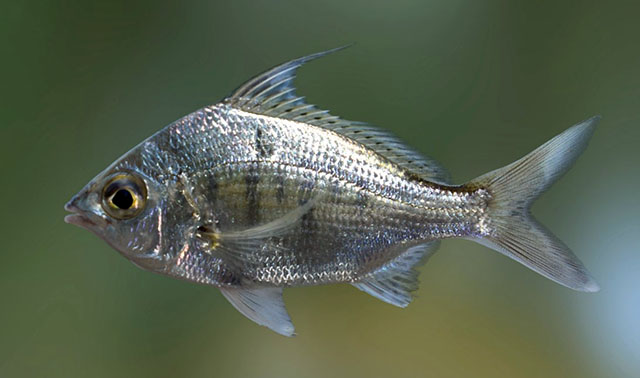| Gerreidae (Mojarras) |
| 39 cm TL (male/unsexed) |
|
demersal; freshwater; brackish; marine; depth range 1 - 50 m, amphidromous |
| Indo-West Pacific: East Africa and Madagascar to Japan and Australia; New Caledonia (Ref. 26587) and Vanuatu (Ref. 13300). Enters rivers and lakes in Madagascar and the east coast of Africa. Not in the Middle East (Ref. 103159). |
|
Dorsal spines (total): 9-9; Dorsal soft rays (total): 10-11; Anal spines: 2-3; Anal soft rays: 7-8. Description: Body depth maximum 2.0-2.5 times in standard length in fish longer than 9 cm standard length, 2.5-3.0 times in standard length in smaller fish (Ref. 4372, 90102). Maxillary reaches beyond level of eye anterior edge (Ref. 48635, 90102). Dorsal fin with 9 spines and 10-11 soft rays; anal fin with 2-3 spines and 7-8 soft rays; second dorsal-fin spine filamentous and very long, 1.7-2.0 times in standard length; pectoral fins reach beyond level of anal fin origin; caudal fin large and forked deeply (Ref. 4372, 4967, 48635, 90102). Scales on lateral line 43-47, and 2-3 scales on caudal fin; 4.5-5.5 scale rows between lateral line and base of 5th dorsal spine (Ref. 4372, 90102). Colouration: Body silvery with 7-10 vertical series of ovoid bluish spots on sides, coalesced as bars in juveniles (Ref. 4372, 90102). |
| Adults are coastal inhabitants found on soft bottoms (Ref. 44894), over sandy substrate (Ref. 12693). Juveniles are found in brackish mangrove estuaries, sometimes enter fresh water (Ref. 2847, 44894), lakes (Ref. 4323), tidal creeks (Ref. 44894) and lower freshwater reaches of rivers (Ref. 12915). Feed on small crustaceans, polychaetes and forams on sand or muddy-sand bottoms (Ref. 12915), worms and insect larvae (Ref. 12693). Length at first reproduction was reported to be around 12 cm SL, for a population in a South African estuary (D. Woodland, pers.comm. 07/13). Salted or made into fish sauce. |
|
Least Concern (LC); Date assessed: 11 July 2016 Ref. (130435)
|
| harmless |
Source and more info: www.fishbase.org. For personal, classroom, and other internal use only. Not for publication.

